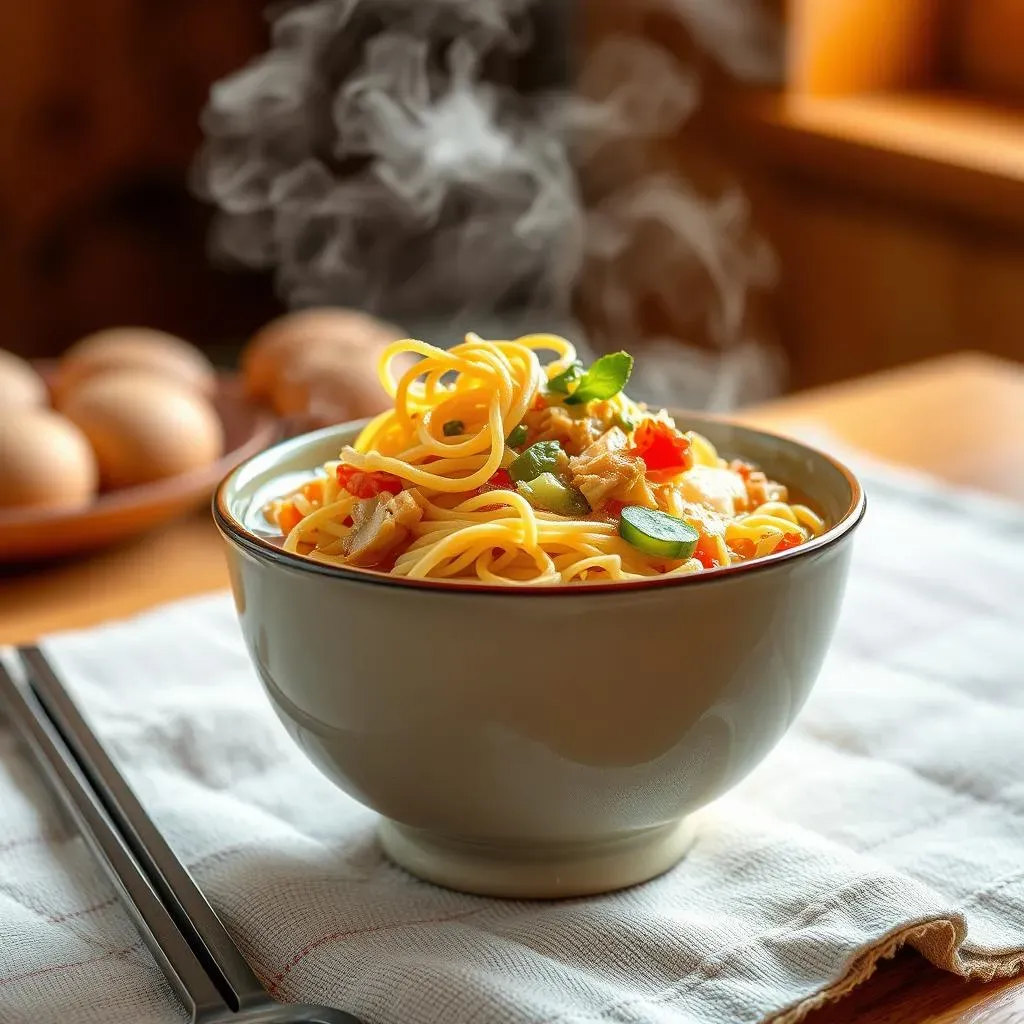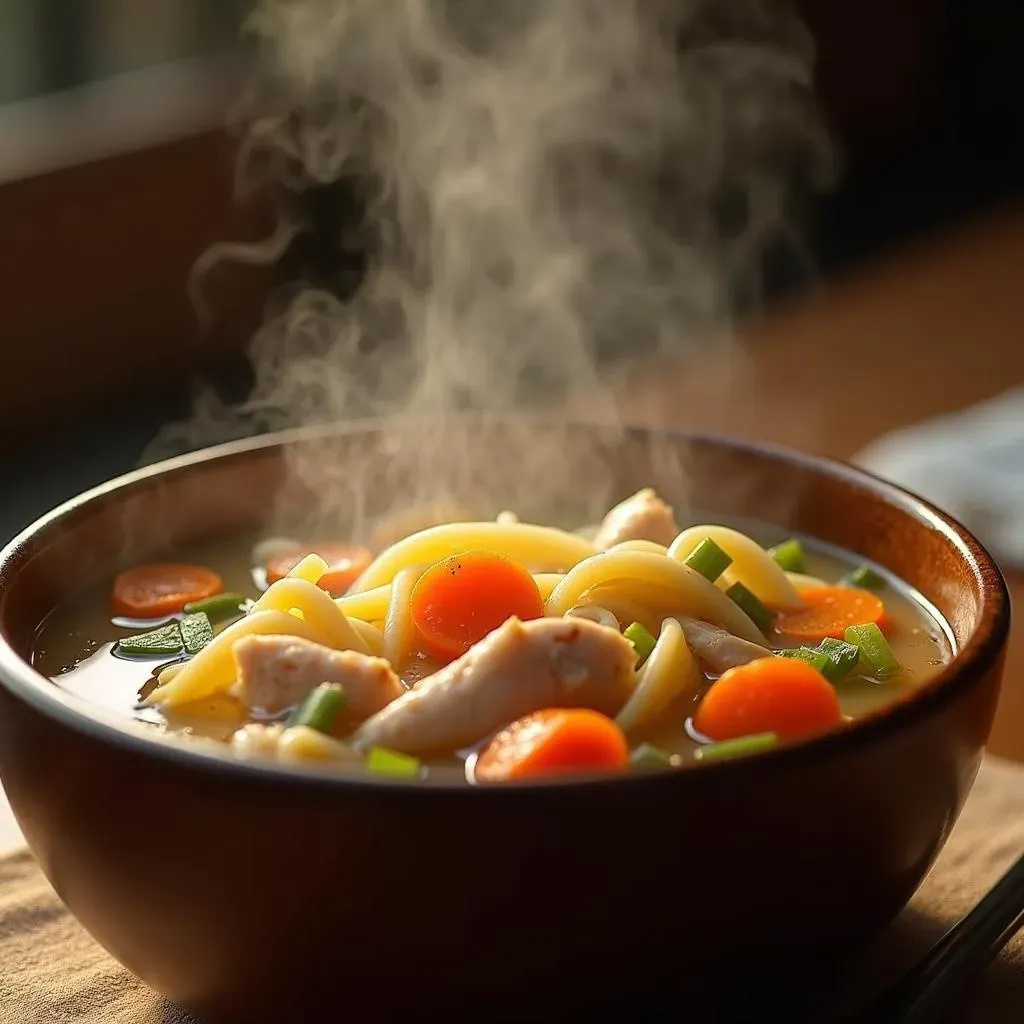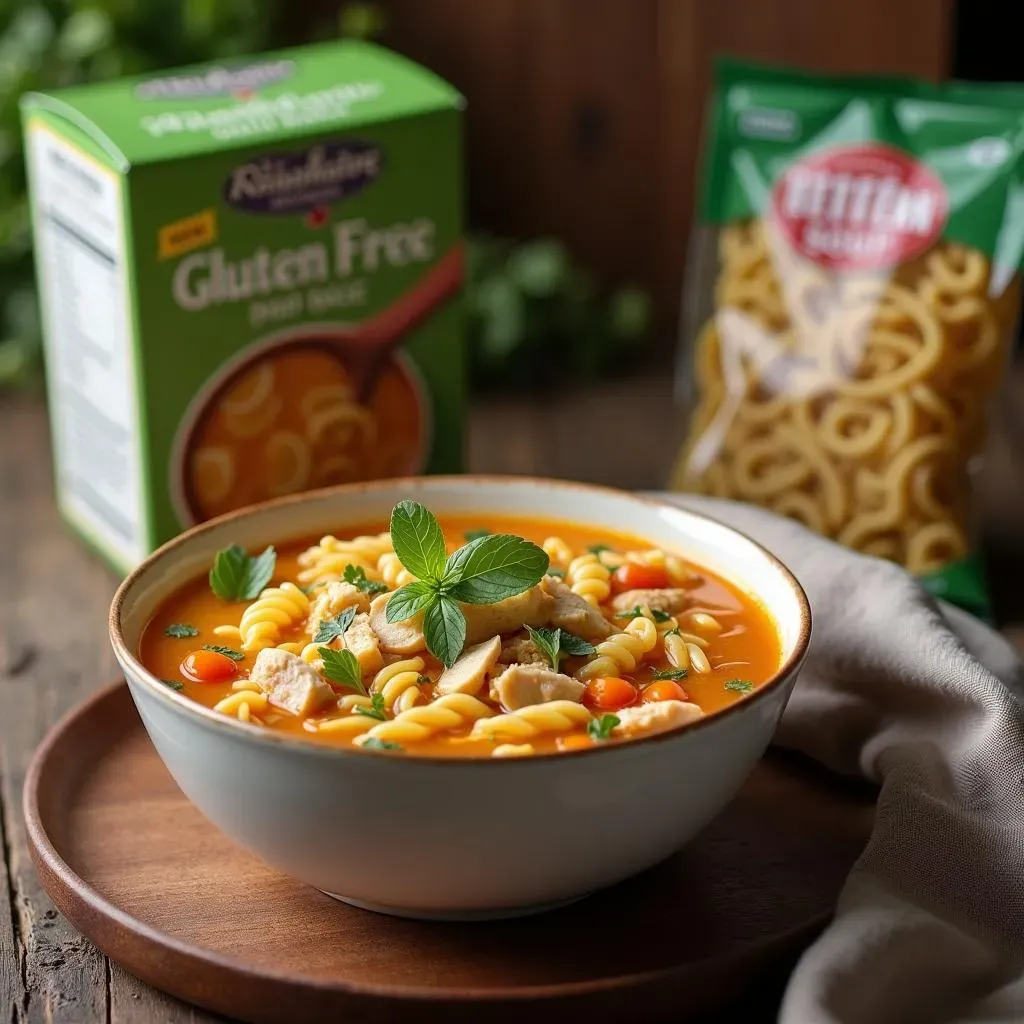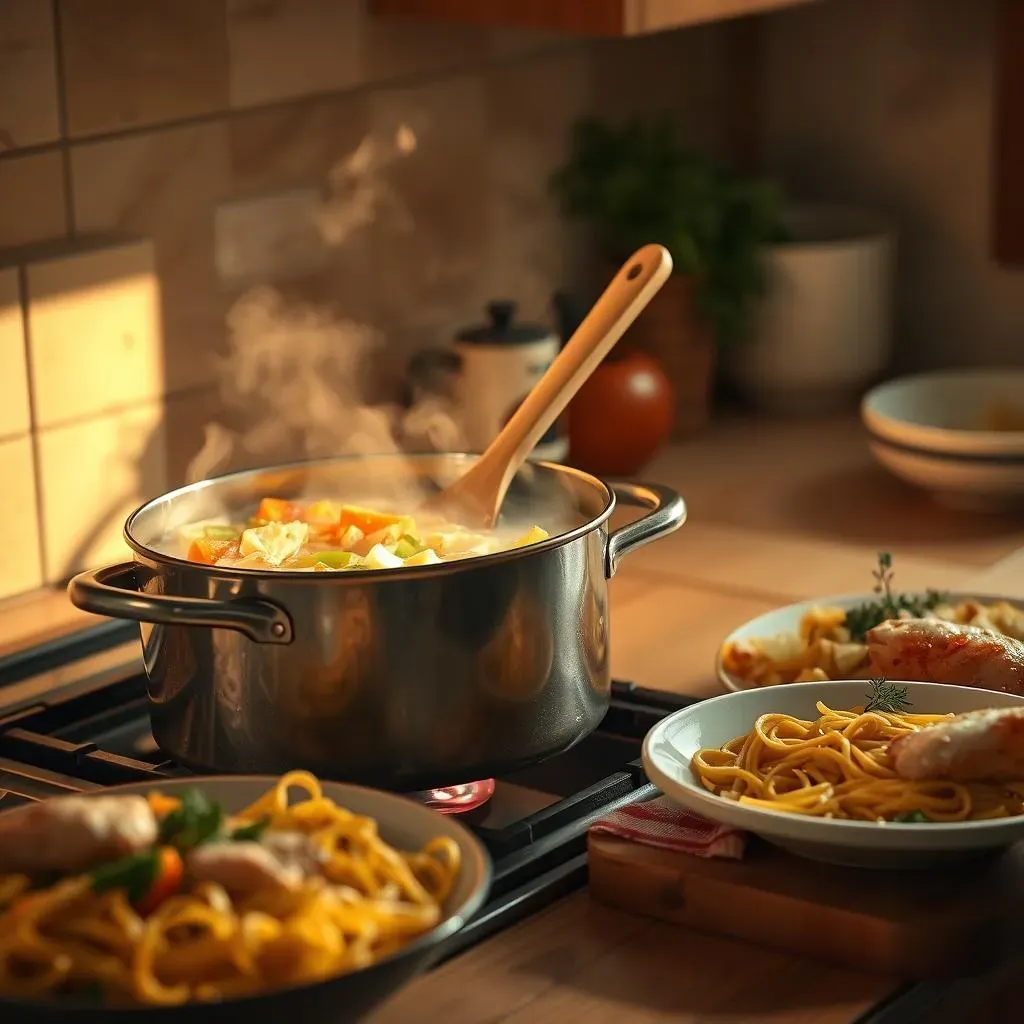Table of Contents
Ever wonder why some chicken noodle soup tastes like a hug in a bowl, while others just taste...blah? We've all been there, staring into a sad, watery bowl, wishing for that homemade goodness. You know, the kind your grandma used to make? The secret isn't some magic spell, it's actually about a few key steps that elevate your soup from bland to grand. This article is all about showing you exactly how to make chicken noodle soup taste homemade, even if you're not a seasoned chef. Forget the canned stuff, we’re diving into real ingredients and techniques. We'll explore the importance of a flavorful broth, how choosing the right noodles can make all the difference, and of course, provide a straightforward recipe to follow. Plus, we'll touch on some handy tips for making the soup ahead of time, freezing it, and even adapting it for those needing gluten-free options. So, grab your apron, and let's get cooking!
The Secret to Amazing Chicken Noodle Soup: It's All About the Broth

The Secret to Amazing Chicken Noodle Soup: It's All About the Broth
The Power of Homemade Stock
Okay, let's be real, the broth is the unsung hero of any great chicken noodle soup. You can’t just toss some water and bouillon cubes in a pot and expect magic. It's like trying to build a house with cardboard, it might look like a house, but it's not going to last, and it certainly won't be sturdy. Instead, we need to create a flavorful foundation. The absolute best way? Homemade chicken stock. Yes, it takes a bit more effort, but trust me, the payoff is huge. We're talking depth of flavor you just can't get from a carton. Think of it as the soul of your soup, the thing that makes it sing.
Now, don't freak out about making stock. It’s easier than you think. I love using a rotisserie chicken for this. You get delicious meat for your soup, and then you use the leftover carcass to make the stock. It’s like getting two meals for the price of one! You toss the bones in a pot with some veggies like carrots, celery, and onions, add water, and let it simmer for a few hours. The result is a rich, golden broth that will make your soup taste like it came straight from a gourmet kitchen. It's seriously that good.
Broth Boosting Tips
Alright, so maybe you don’t have time to make stock from scratch every time. No worries, I get it. Even if you're using store-bought broth, there are ways to boost its flavor. One trick I often use is adding some roasted garlic. The roasting brings out a sweet, nutty flavor that is simply amazing. Throw in a few cloves, or a whole head, cut in half, into the oven while you are cooking and add it to the broth. Another great thing to add is some fresh herbs. Thyme and bay leaves are classic choices, but don't be afraid to experiment with rosemary or parsley. Just remember to remove them before serving. And of course, salt is your friend. Don't be shy with it, it's what brings all the flavors together.
Another great tip is to use bone broth if you can find it. Bone broth is a bit richer and more flavorful than regular chicken broth. It also has more collagen, which is great for you. It’s a fantastic shortcut when you're short on time but still want that homemade taste. Just remember, the key is to layer flavors. Don't rely on just one ingredient, use a combination of things to make your broth really shine.
Ingredient | Flavor Boost | How to Use |
|---|---|---|
Roasted Garlic | Sweet, nutty, mellow | Roast whole head, add to broth while simmering |
Fresh Herbs (Thyme, Bay Leaf) | Earthy, aromatic | Add to broth while simmering, remove before serving |
Bone Broth | Rich, deep, collagen-rich | Use as base or mix with regular broth |
Salt | Enhances all other flavors | Add to taste, start with a teaspoon and adjust |
Noodle Nirvana: Choosing the Right Noodles for Your Homemade Soup

Noodle Nirvana: Choosing the Right Noodles for Your Homemade Soup
Okay, so you’ve got your amazing broth simmering, now it’s time to talk noodles. I mean, let's be honest, the noodles are a big part of what makes chicken noodle soup so comforting. It’s like choosing the right shoes for a long walk, you need something that fits just right. You wouldn't wear flip-flops on a hike, right? Same goes for noodles. The type of noodle you pick can totally change the feel of your soup. We’re not just talking about carbs here, we're talking texture, how much broth they soak up, and overall deliciousness. So, let’s explore some options and find the perfect match for your soup.
First up, let’s talk about the classics. Egg noodles are probably the most traditional choice for chicken noodle soup. They’re soft, chewy, and they have this wonderful richness that just works. They're like the cozy blanket of the noodle world. Then you have your standard pasta shapes – like small shells, ditalini, or even elbow macaroni. These are great for kids and for when you want something a bit more fun. They tend to hold their shape well, so they don’t get mushy in the soup. But then we get to the really interesting stuff! Have you ever tried using homemade noodles? Oh man, the difference is night and day. They’re a bit more work, sure, but it's like adding an extra layer of love to the soup.
Now, if you’re feeling adventurous, there are some less conventional options to consider. Think about using something like orzo or even farro. These add a slightly different texture, they are a bit firmer. They can be a great way to change things up if you are tired of the same old thing. And if you're gluten-free, don't worry, you're not left out! There are tons of great gluten-free noodles out there, from rice noodles to those made with quinoa or corn. The key is to find one that you like the texture of, and that does not get too mushy in the broth. It’s like finding the perfect pair of jeans, it might take a few tries, but when you find the right fit, it's a game-changer.
Noodle Type | Texture | Best For |
|---|---|---|
Egg Noodles | Soft, chewy | Classic chicken noodle soup |
Small Pasta Shapes (shells, ditalini) | Firm, holds shape | Kid-friendly, good for holding shape |
Homemade Noodles | Rich, slightly chewy | Elevated flavor, special occasion |
Orzo, Farro | Firm, slightly chewy | Adding a different texture |
Gluten-Free Noodles | Varies | For gluten-free diets |
How to Make Chicken Noodle Soup Taste Homemade: StepbyStep

How to Make Chicken Noodle Soup Taste Homemade: StepbyStep
Alright, friend, let's get down to the nitty-gritty. You've got your amazing broth, your perfect noodles picked out, now it's time to bring it all together. Making homemade chicken noodle soup isn't rocket science, but there are a few key steps that will make all the difference. First, we're going to start by sautéing some veggies. Think diced onions, carrots, and celery – the holy trinity of soup. Melt some butter in a pot, and cook them until they’re softened, and the onions are translucent. This is where the flavor building starts, so don't rush it. Then add in your garlic, if you are using it, cook for about a minute more until fragrant. This step is crucial because it creates a flavorful base for the rest of the soup.
Next, pour in your glorious broth. Whether it's homemade or store-bought, this is where it all comes together. Add your seasonings now, salt, pepper, and any herbs you are using, and bring the whole thing to a gentle simmer. Now, if you are using raw chicken, this is the time to add it. If you are using pre-cooked chicken, then hold off for now. Let it simmer until the chicken is cooked through, if you are using raw chicken. Then, take the chicken out and shred it with two forks. Now, add in your noodles and cook them according to package directions. Usually, it's until they are al dente, or just tender. Once the noodles are done, add back the shredded chicken, and any other veggies you want to add, like some chopped fresh parsley. Give it a good stir and let it heat through. Then, serve your soup hot, and enjoy! You just made a bowl of liquid gold!
Step | Action | Why it Matters |
|---|---|---|
1 | Sauté veggies in butter | Builds a flavorful base |
2 | Add broth and seasonings | Creates the soup's foundation |
3 | Add raw chicken (if using) and simmer | Cooks the chicken and infuses flavor |
4 | Shred cooked chicken | Prepares chicken for adding back in |
5 | Add noodles and cook | Adds texture and substance |
6 | Add shredded chicken back in and warm through | Finishes the soup and adds flavor |
MakeAhead Tips, Freezing Advice, and GlutenFree Options for Your Soup

MakeAhead Tips, Freezing Advice, and GlutenFree Options for Your Soup
Okay, so life happens, right? Sometimes you need that comforting bowl of chicken noodle soup, but you don't have hours to spend in the kitchen. That's where make-ahead tips and freezing come in clutch. The beauty of this soup is that it actually tastes even better the next day, as the flavors have more time to meld. If you're planning to make it ahead, just cook the soup as directed, but hold off on adding the noodles. They can get a bit mushy if they sit in the broth for too long. Instead, store the soup base in the fridge for up to three days. When you're ready to serve, just reheat the soup and cook your noodles separately, then add them in. It's a total game changer for busy weeknights or when you're meal prepping for the week.
Now, let’s talk about freezing. Chicken noodle soup freezes like a dream, but there are a couple of things to keep in mind. Again, it’s best to freeze the soup base without the noodles. When you're ready to enjoy, thaw the soup in the fridge overnight, or use the defrost setting on your microwave, then reheat on the stove. Once it’s simmering, throw in your noodles and cook until done. This prevents them from getting all bloated and gross. Another tip is to freeze the soup in individual portions. This makes it super easy to grab a serving for lunch or a quick dinner. I often use mason jars for this, but any freezer-safe container will do. It's like having your own personal stash of comfort on hand.
Situation | Tip | Why It Works |
|---|---|---|
Making Ahead | Cook soup base, hold noodles | Prevents mushy noodles, saves time |
Freezing | Freeze soup base, cook noodles later | Maintains noodle texture, convenient |
Freezing Portions | Use individual containers | Easy to grab and go |
And finally, let's chat gluten-free options. If you're avoiding gluten, you absolutely don't have to miss out on the joy of chicken noodle soup. There are so many fantastic gluten-free noodles available these days. You can find everything from rice noodles to those made with quinoa or corn. They’re all great options. Just be sure to check the cooking times, as they can vary quite a bit. Some need to be cooked separately and added at the end, while others can be cooked directly in the broth, just like regular noodles. Another option is to make your own gluten-free egg noodles, it will take a bit more time, but the result is worth it. And if you are using a store-bought chicken broth, make sure it is gluten free as well. With a few simple swaps, you can make a delicious and comforting soup that everyone can enjoy.
"The best way to make a dish your own is to adapt it to your needs and preferences."
- Gluten-Free Noodles: Rice noodles, quinoa noodles, corn noodles.
- Gluten-Free Broth: Check labels to ensure it's gluten-free.
- Homemade Options: Consider making your own gluten-free egg noodles.
